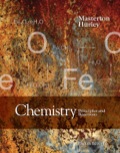
At 800°C,
Calculate K at 8000C for
(a) the synthesis of one mole of H2S from H2 and S2 gases.
(b) the decomposition of one mole of H2S gas.
(a)
Interpretation:
The equilibrium constant for the formation of 1 mol of
Concept introduction:
The system is said to be in equilibrium if the there is no change in the partial pressure or concentration of reactant and product takes place.
For a general reaction as follows:
The expression for the equilibrium constant is represented as follows:
Here, to calculate the equilibrium constant, the values of partial pressure of all the species in reactant and product side are required.
Answer to Problem 16QAP
The equilibrium constant for the synthesis of 1 mol of
Explanation of Solution
The given equilibrium reaction is as follows:
The value of equilibrium constant at
The expression for the equilibrium constant will be:
Thus,
Now, the reaction for the synthesis of 1 mol of
The expression for the equilibrium constant of the above reaction will be:
Since,
Taking reciprocal of the above equation:
Now, taking square root:
Therefore, equilibrium constant for the synthesis of 1 mol of
(b)
Interpretation:
The equilibrium constant for the decomposition of 1 mol of
Concept introduction:
The system is said to be in equilibrium if the there is no change in the partial pressure or concentration of reactant and product takes place.
For a general reaction as follows:
The expression for the equilibrium constant is represented as follows:
Here, to calculate the equilibrium constant, the values of partial pressure of all the species in reactant and product side are required.
Answer to Problem 16QAP
The equilibrium constant for the decomposition of 1 mol of
Explanation of Solution
The given equilibrium reaction is as follows:
The value of equilibrium constant at
The expression for the equilibrium constant will be:
Thus,
The reaction for the decomposition of 1 mol of
The expression for the equilibrium constant will be:
Since,
Taking square root:
Therefore, the equilibrium constant for the decomposition of 1 mol of
Want to see more full solutions like this?
Chapter 12 Solutions
EBK CHEMISTRY: PRINCIPLES AND REACTIONS
- What is the final product when D-galactose reacts with hydroxylamine?arrow_forwardIndicate the formula of the product obtained by reacting methyl 5-chloro-5-oxopentanoate with 1 mole of 4-penten-1-ylmagnesium bromide.arrow_forwardIn the two chair conformations of glucose, the most stable is the one with all the OH groups in the equatorial position. Is this correct?arrow_forward
- please help me with my homeworkarrow_forwardhelparrow_forwardThe temperature on a sample of pure X held at 1.25 atm and -54. °C is increased until the sample boils. The temperature is then held constant and the pressure is decreased by 0.42 atm. On the phase diagram below draw a path that shows this set of changes. pressure (atm) 2 0 0 200 400 temperature (K) Xarrow_forward
- QUESTION: Answer Question 5: 'Calculating standard error of regression' STEP 1 by filling in all the empty green boxes *The values are all provided in the photo attached*arrow_forwardpressure (atm) 3 The pressure on a sample of pure X held at 47. °C and 0.88 atm is increased until the sample condenses. The pressure is then held constant and the temperature is decreased by 82. °C. On the phase diagram below draw a path that shows this set of changes. 0 0 200 temperature (K) 400 аarrow_forwarder your payment details | bar xb Home | bartleby x + aleksogi/x/isl.exe/1o u-lgNskr7j8P3jH-1Qs_pBanHhviTCeeBZbufuBYT0Hz7m7D3ZcW81NC1d8Kzb4srFik1OUFhKMUXzhGpw7k1 O States of Matter Sketching a described thermodynamic change on a phase diagram 0/5 The pressure on a sample of pure X held at 47. °C and 0.88 atm is increased until the sample condenses. The pressure is then held constant and the temperature is decreased by 82. °C. On the phase diagram below draw a path that shows this set of changes. pressure (atm) 1 3- 0- 0 200 Explanation Check temperature (K) 400 X Q Search L G 2025 McGraw Hill LLC. All Rights Reserved Terms of Use Privacy Cearrow_forward
 Chemistry & Chemical ReactivityChemistryISBN:9781337399074Author:John C. Kotz, Paul M. Treichel, John Townsend, David TreichelPublisher:Cengage Learning
Chemistry & Chemical ReactivityChemistryISBN:9781337399074Author:John C. Kotz, Paul M. Treichel, John Townsend, David TreichelPublisher:Cengage Learning Chemistry: An Atoms First ApproachChemistryISBN:9781305079243Author:Steven S. Zumdahl, Susan A. ZumdahlPublisher:Cengage Learning
Chemistry: An Atoms First ApproachChemistryISBN:9781305079243Author:Steven S. Zumdahl, Susan A. ZumdahlPublisher:Cengage Learning Chemistry by OpenStax (2015-05-04)ChemistryISBN:9781938168390Author:Klaus Theopold, Richard H Langley, Paul Flowers, William R. Robinson, Mark BlaserPublisher:OpenStax
Chemistry by OpenStax (2015-05-04)ChemistryISBN:9781938168390Author:Klaus Theopold, Richard H Langley, Paul Flowers, William R. Robinson, Mark BlaserPublisher:OpenStax Chemistry: Principles and ReactionsChemistryISBN:9781305079373Author:William L. Masterton, Cecile N. HurleyPublisher:Cengage Learning
Chemistry: Principles and ReactionsChemistryISBN:9781305079373Author:William L. Masterton, Cecile N. HurleyPublisher:Cengage Learning General Chemistry - Standalone book (MindTap Cour...ChemistryISBN:9781305580343Author:Steven D. Gammon, Ebbing, Darrell Ebbing, Steven D., Darrell; Gammon, Darrell Ebbing; Steven D. Gammon, Darrell D.; Gammon, Ebbing; Steven D. Gammon; DarrellPublisher:Cengage Learning
General Chemistry - Standalone book (MindTap Cour...ChemistryISBN:9781305580343Author:Steven D. Gammon, Ebbing, Darrell Ebbing, Steven D., Darrell; Gammon, Darrell Ebbing; Steven D. Gammon, Darrell D.; Gammon, Ebbing; Steven D. Gammon; DarrellPublisher:Cengage Learning Chemistry: The Molecular ScienceChemistryISBN:9781285199047Author:John W. Moore, Conrad L. StanitskiPublisher:Cengage Learning
Chemistry: The Molecular ScienceChemistryISBN:9781285199047Author:John W. Moore, Conrad L. StanitskiPublisher:Cengage Learning





